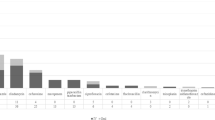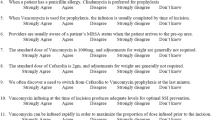Abstract
Background
Surgical antibiotic prophylaxis (SAP) has become the standard of care in orthopaedic surgery. Inappropriate usage of antibiotics (dosage, strength, and/or administration time and duration) can inadvertently result in superadded infections and antimicrobial resistance. The purpose of this study was to document and analyse the prescription patterns for SAP, and to investigate the factors associated with divergence from standard guidelines.
Methods
We conducted an online cross-sectional questionnaire-based study to collect information about the SAP practices of the members of the Indian Orthopaedic Association (IOA) using Google forms. A link to the questionnaire was sent by e-mails.
Results
The overall response rate was 5.73%. While 97.3% respondents practised SAP routinely, the practice was not aligned with standard guidelines’ recommendations. There was heterogeneity in the use of SAP in terms of choice of antibiotic(s), number of co-prescribed drugs, single- versus multiple-dose regimens, and the duration of therapy. The prescription practice patterns showed that orthopaedic surgeons almost always used broad-spectrum antibiotics for long durations, regardless of the type of surgery.
Conclusion
While Orthopaedic surgeons in India are practicing SAP, the pattern of antibiotic usage is heterogeneous. Variations were noted in the choice of antibiotics for different types of surgeries, time of administration, duration of usage in the postoperative period as well as co-prescriptions. This study highlights the urgent need for a comprehensive, rational, and robust national SAP policy for orthopaedic surgeries.


Similar content being viewed by others
References
Yeap, J. S., Lim, J. W., Vergis, M., Au Yeung, P. S., Chiu, C. K., & Singh, H. (2006). Prophylactic antibiotics in orthopaedic surgery: guidelines and practice. Medical Journal of Malaysia, 61(2), 181–188.
Mathur, P., Trikha, V., Farooque, K., Sharma, V., Jain, N., Bhardwaj, N., et al. (2013). Implementation of a short course of prophylactic antibiotic treatment for prevention of postoperative infections in clean orthopaedic surgeries. Indian Journal of Medical Research, 137(1), 111–116.
Hawn, M. T., & Knowlton, L. M. (2019). Balancing the risks and benefits of surgical prophylaxis: timing and duration do matter. JAMA Surgery, 154(7), 598–599.
Sewell, M., Adebibe, M., Jayakumar, P., Jowett, C., Kong, K., Vemulapalli, K., et al. (2011). Use of the WHO surgical safety checklist in trauma and orthopaedic patients. International Orthopaedics, 35(6), 897–901.
Argaw, N. A., Shumbash, K. Z., Asfaw, A. A., & Hawaze, S. (2017). Assessment of surgical antimicrobial prophylaxis in Orthopaedics and Traumatology Surgical Unit of a Tertiary Care Teaching Hospital in Addis Ababa. BMC Research Notes, 10(1), 160.
Andersson, A. E., Bergh, I., Karlsson, J., Eriksson, B. I., & Nilsson, K. (2012). The application of evidence-based measures to reduce surgical site infections during orthopedic surgery—report of a single-center experience in Sweden. Patient Safety in Surgery, 6(1), 11.
Queiroz, R., Grinbaum, R. S., Galvão, L. L., Tavares, F. G., & Bergsten-Mendes, G. (2005). Antibiotic prophylaxis in orthopedic surgeries: the results of an implemented protocol. Brazilian Journal of Infectious Disease, 9(4), 283–287.
İnan, A. (2011). Antibiotic use and cost in a teaching hospital in İstanbul. Journal of Microbiology and Infectious Disease, 1(3), 128–133.
Şengel, B. E., Bilgin, H., Bilgin, B. Ö., Gidener, T., Saydam, S., Pekmezci, A., et al. (2019). The need for an antibiotic stewardship program in a hospital using a computerized pre-authorization system. International Journal of Infectious Diseases, 82, 40–43.
Bhatnagar, N., Sural, S., Arora, S., Lingaiah, P., & Dhal, A. (2017). Efficacy of single dose versus multiple dose injectable antibiotics in hip joint surgery. Journal of Orthopaedics Trauma Surgery and Related Research, 12(2), 62–65.
Jaggi, N., Nirwan, P., & Chakraborty, M. (2018). Adherence to surgical antibiotic prophylaxis guidelines in an Indian tertiary care hospital. Journal of Patient Safety and Infection Control, 6, 13–18.
Kumari, P., Siddegowda, J. B., & Krishnaiah, V. (2019). Appropriateness and pharmacoeconomics of surgical antimicrobial prophylaxis in open reduction internal fixation surgery practiced in a tertiary hospital compared to recommendations in the national center for disease control guidelines. Perspectives in Clinical Research, 10(4), 172–176.
National Action Plan on Antimicrobial Resistance (NAP-AMR) 2017–2021 [Internet]. National Centre for Disease Control (NCDC); 2017. https://www.ncdc.gov.in/WriteReadData/linkimages/AMR/File645.pdf. Accessed 08 Oct 2020
Ranjalkar, J., & Chandy, S. J. (2019). India’s National Action Plan for antimicrobial resistance—an overview of the context, status, and way ahead. Journal of Family Medicine and Primary Care, 8(6), 1828–1834.
Hand, T. L., Hand, E. O., Welborn, A., & Zelle, B. A. (2020). Gram-negative antibiotic coverage in Gustilo–Anderson type-III open fractures. Journal of Bone and Joint Surgery, 102(16), 1468–1474.
Bratzler, D. W., Dellinger, E. P., Olsen, K. M., Perl, T. M., Auwaerter, P. G., Bolon, M. K., et al. (2013). Clinical practice guidelines for antimicrobial prophylaxis in surgery. American Journal of Health System Pharmacy, 70(3), 195–283.
World Health Organization. Global guidelines for the prevention of surgical site infection. 2016. https://apps.who.int/iris/bitstream/handle/10665/250680/9789241549882-eng.pdf?sequence=8. Accessed 08 Oct 2020
National treatment guidelines for antimicrobial use in infectious diseases version 1.0. National Centre for Disease Control (NCDC); 2016. https://www.ncdc.gov.in/WriteReadData/l892s/File622.pdf. Accessed 08 Oct 2020
Gans, I., Jain, A., Sirisreetreerux, N., Haut, E. R., & Hasenboehler, E. A. (2017). Current practice of antibiotic prophylaxis for surgical fixation of closed long bone fractures: a survey of 297 members of the Orthopaedic Trauma Association. Patient Safety in Surgery, 11(1), 2.
Garner, M. R., Sethuraman, S. A., Schade, M. A., & Boateng, H. (2020). Antibiotic prophylaxis in open fractures: evidence, evolving issues, and recommendations. Journal of American Academy of Orthopaedic Surgeons, 28(8), 309–315.
Lingaraj, R., Santoshi, J. A., Devi, S., Najimudeen, S., Gnanadoss, J. J., Kanagasabai, R., et al. (2015). Predebridement wound culture in open fractures does not predict postoperative wound infection: A pilot study. Journal of Natural Science Biology and Medicine, 6(Suppl 1), S63–S68.
Carver, D. C., Kuehn, S. B., & Weinlein, J. C. (2017). Role of systemic and local antibiotics in the treatment of open fractures. Orthopedic Clinics of North America, 48(2), 137–153.
Kandel, C. E., Gill, S., McCready, J., Matelski, J., & Powis, J. E. (2016). Reducing co-administration of proton pump inhibitors and antibiotics using a computerized order entry alert and prospective audit and feedback. BMC Infectious Diseases, 16, 355.
Ogawa, R., & Echizen, H. (2011). Clinically significant drug interactions with antacids: An update. Drugs, 71(14), 1839–1864.
Shahzad, S., Ashraf, M. A., Sajid, M., Shahzad, A., Rafique, A., & Mahmood, M. S. (2018). Evaluation of synergistic antimicrobial effect of vitamins (A, B1, B2, B6, B12, C, D, E and K) with antibiotics against resistant bacterial strains. Journal of Global Antimicrobial Resistance, 13, 231–236.
Rodgers, B., Kirley, K., & Mounsey, A. (2013). Prescribing an antibiotic? Pair it with probiotics. Journal of Family Practice, 62(3), 148–150.
Norlin, A. C., Hansen, S., Wahren-Borgström, E., Granert, C., Björkhem-Bergman, L., & Bergman, P. (2016). Vitamin D3 supplementation and antibiotic consumption—results from a prospective, observational study at an Immune-Deficiency Unit in Sweden. PLoS ONE, 11(9), e0163451.
Cursino, L., Chartone-Souza, E., & Nascimento, A. M. A. (2005). Synergic interaction between ascorbic acid and antibiotics against Pseudomonas aeruginosa. Brazilian Archives of Biology and Technology, 48(3), 379–384.
Kwiecińska-Piróg, J., Skowron, K., Bogiel, T., Białucha, A., Przekwas, J., & Gospodarek-Komkowska, E. (2019). Vitamin C in the presence of sub-inhibitory concentration of aminoglycosides and fluoroquinolones alters proteus mirabilis biofilm inhibitory rate. Antibiotics, 8(3), 116.
Dhammi, I. K., Ul Haq, R., & Kumar, S. (2015). Prophylactic antibiotics in orthopedic surgery: Controversial issues in its use. Indian Journal of Orthopaedics, 49(4), 373–376.
Author information
Authors and Affiliations
Contributions
Conceptualisation: JAS, PB. Methodology: JAS, MN, RS. Formal analysis and investigation: PB, AC. Writing—original draft preparation: JAS, PB, MN. Writing—review and editing: RS. Funding acquisition: not applicable. Resources: AC (software for statistical analysis). Supervision: RS.
Corresponding author
Ethics declarations
Conflict of interest
The authors declare that they have no conflict of interest.
Ethical standard statement
All procedures performed in studies involving human participants were in accordance with the ethical standards of the Institutional Human Ethics Committee, All India Institute of Medical Sciences, Bhopal, MP, India, IHEC-LOP/2020/IM0243, and with the 1964 Helsinki declaration and its later amendments or comparable ethical standards.
Informed consent
Informed consent was obtained from all individual participants included in the study.
Additional information
Publisher's Note
Springer Nature remains neutral with regard to jurisdictional claims in published maps and institutional affiliations.
Electronic supplementary material
Below is the link to the electronic supplementary material.
43465_2020_306_MOESM1_ESM.pdf
Supplementary file1 Shows the relation of the age of the respondent and the years of experience in relation to their major field of orthopaedic practice (PDF 153 KB)
Rights and permissions
About this article
Cite this article
Santoshi, J.A., Behera, P., Nagar, M. et al. Current Surgical Antibiotic Prophylaxis Practices: A Survey of Orthopaedic Surgeons in India. JOIO 55, 749–757 (2021). https://doi.org/10.1007/s43465-020-00306-0
Received:
Accepted:
Published:
Issue Date:
DOI: https://doi.org/10.1007/s43465-020-00306-0




